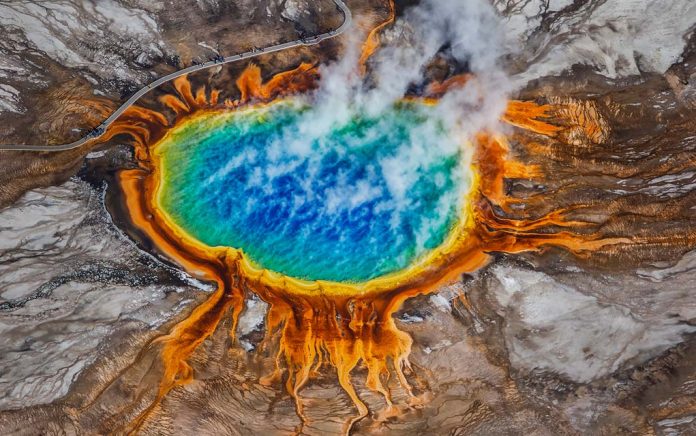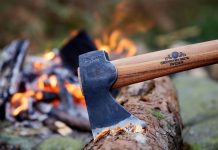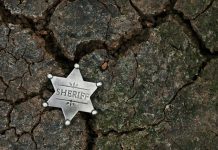(SurvivalDaily.com) – Famous for its geysers and hot springs, Yellowstone National Park is one of the most beautiful places you can visit – but it’s also home to a threat capable of crippling the country… and possibly the world.
A “Super” Disaster
Beneath the surface of Yellowstone National Park lies a danger that is unmatched by other natural disasters – a supervolcano. The term “supervolcano” is used for any volcanic eruption that expels at least 250 cubic miles of magma. The scary part of this one is that it is active and it has erupted in the past – on at least three occasions.
The first eruption was 2.1 million years ago, the second 1.3 million, and the third 640,000 years ago. Each eruption was large enough to make the Mount St. Helens blast look minuscule in comparison.
Will It Blow Again?
The question isn’t if the supervolcano will erupt again; it’s when. Yellowstone seems to operate on a roughly 700,000-year cycle, give or take a few thousand years. Most scientists believe the volcano will erupt again, but they aren’t sure when.
Luckily, the site is monitored constantly by the Yellowstone Volcano Observatory (YVO) for earthquakes, tilt, temperature, geothermal discharge and ground deformation. This means that, should the volcano decide to “wake up”, we could expect to have advance warning.
When It Goes Boom…
The most recent major explosion at Yellowstone, the Lava Creek eruption, launched 240 cubic miles of volcanic debris into the atmosphere. Compare this to the 1815 Mount Tambora eruption, the most violent volcanic event on earth in modern history. This blast spewed out 12 cubic miles of debris, which cooled much of the planet and caused crop failures and starvation across Europe and North America.
If Yellowstone were to have a full-scale eruption today, the results would be devastating. The initial blast would decimate everything within a few hundred kilometers of the crater, and would send enough ash into the air to cover most of the United States and Canada in a layer several inches thick.
Agriculture would grind to a halt and global temperatures would plummet due to the ash cloud choking out sunlight – potentially for a decade. The sunlight wouldn’t be the only thing choking either; volcanic ash will clog engines, and can lead to silicosis in humans and animals alike.
Let’s not forget that volcanic ash (which is actually pulverized rock) is heavy. As it collects on structures, the likelihood of catastrophic building damage, and even collapse, increases. It is also capable of blocking rivers, which complicates things even further.
What Can We Do?
The first and most obvious preparation for this event is to get as far away from it as possible. Anyone living in the immediate vicinity of the caldera will likely perish in the blast. If the volcano begins to give us warning signs, pack up and head as far south as you can get. In all likelihood, the government will give an evacuation order, if they have enough time to do so.
Next, stock up on food. We don’t mean to beat a dead horse but having a stockpile of emergency supplies is applicable for nearly all disasters, and this one is no exception. The threat of famine will be extremely high in the aftermath of a supervolcano explosion. A combination of the “volcanic winter” and ash deposits will basically destroy all crops in North America and cause widespread crop failures around the world, so you do not want to rely on growing your own food until the skies clear up.
Invest in good filtration gear. Standard dust masks will not filter out small particles of volcanic ash, and breathing these can lead to serious health issues. Opt for dust masks that have HEPA filters; those with an N-95 rating are the most recommended.
At home, close your windows, doors, and fireplace (if you have one). Tape off any areas that may have a draft, or use a damp towel here. Set your air conditioner/heater to recirculate the air in your house – or shut it off.
If you live somewhere that’s usually warm, go get some cold-weather clothing. The ash cloud will block out the sun, causing the temperature to drop significantly. The Mount Tambora eruption caused the so-called “year without a summer” in 1816 – and that was a minor blast compared to the potential eruption of a supervolcano.
You also need to consider the fact that water supplies are likely going to be contaminated by the ash. This makes the water undrinkable. To counter this, stock up on as much water as you can before the ash cloud reaches you. Reverse osmosis filters can also be used on water contaminated with volcanic fallout, as they will remove the heavy metals associated with the ash.
The fact is, no one knows when the next eruption will occur – but when it does, it will be a TEOTWAWKI level situation. The more you know now, the better your chances of survival will be, should this take place in our lifetimes.
Have you heard of the Yellowstone Supervolcano before? Do you think it will erupt in our lifetime? Reply to your email and share your thoughts, we would love to hear from you!
Copyright 2021, SurvivalDaily.com

















